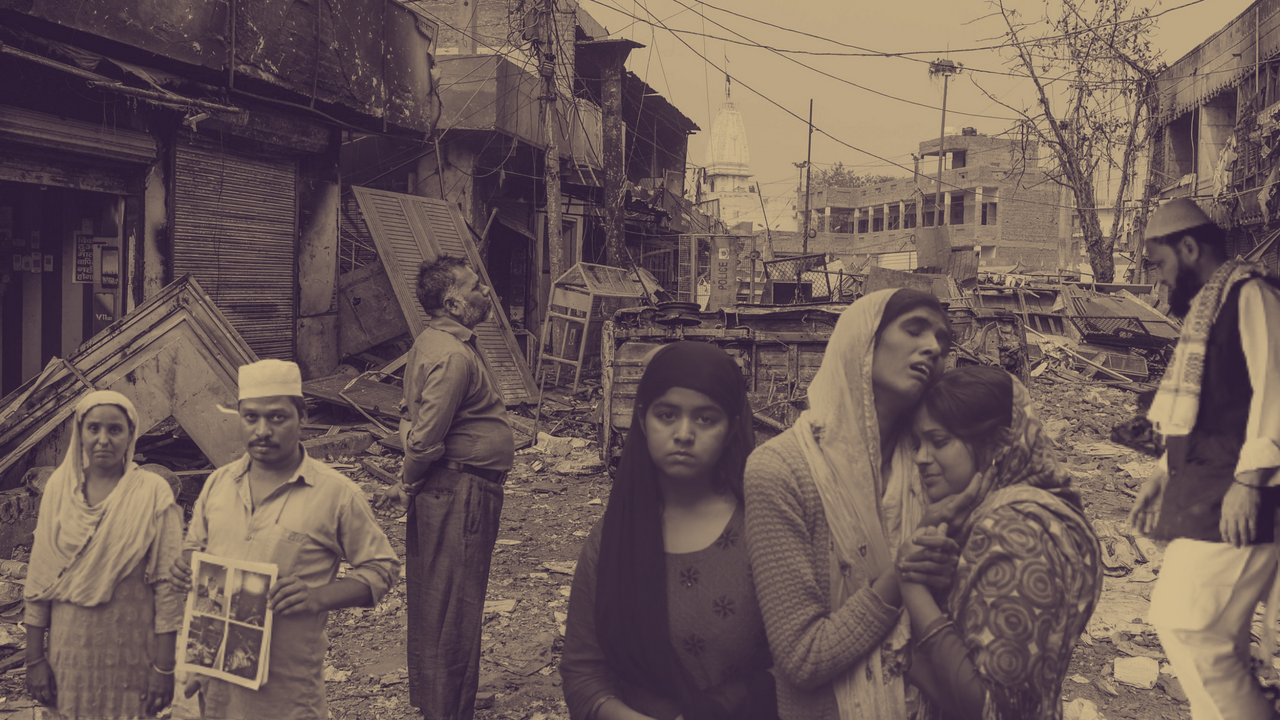Delhi Pogrom was a state-sponsored attack on Muslims of northeast Delhi that took place last year on 23rd February as armed Hindu mobs, that were called from outside on a few hundred rupees, killed Muslims in the broad daylight and set their houses, vehicles, and shops ablaze. But there is a catch. Muslim houses and shops were not directly burned. They were first looted. And it was their local Hindu neighbours, living with them for years, who helped mobs in targeting property owned by Muslims only. Otherwise, an outsider could not know which house belongs to whom.
Popular media channels loudly reported isolated incidents when local Hindus had protected Muslim lives—but those episodes of communal harmony did more harm than they benefitted as they only suppressed discomforting facts. Many popular journalists started false-balancing and called it a riot when many local Hindus also joined mobs in looting Muslim houses and shops while they had waved saffron flags on their own houses for religious identification. It was a pattern as it happens during almost every pogrom—right from Delhi anti-Muslim violence of 1947 (which erupted after partition) to the Delhi pogrom of 1947. When mobs caught a person, whose religious identity was not identifiable through their clothes or facial hair, they forced them to drop their pant as Muslim men are circumcised. “My penis became my identity card,” said journalist Manav Sushil, who was attacked by a mob, “My life is secure in this country solely because my penis is not circumcised.”
Casualties
Muslims who lived in a Hindu dominated area, like Shiv Vihar, bore the most gruesome violence as they could not flee their home. Many were burned alive inside their own house and many were killed while running and their bodies were thrown in the nearby sewer. For days, their corpses were not taken out and the area was sealed so that no activist could visit it. According to a BBC report, police were complicit in the violence. It was evident from the viral video where police officers were seen forcing injured Muslim men, lying on the ground, to sing Vande Mataram and the National Anthem. One of them was Faizan who later succumbed to his injuries. Moreover, any Muslim that police officers on duty illegally picked faced custodial torture and they were latter slapped by fictional cases. Many continue to languish in jail even today. Khalid Saifi and Ishrat Jahan are two of them that were picked on the day of violence.



Once the violence dimmed down, Muslims, who became homeless as their house was burned, lived like refugees in Eidgah Relief Camp in Mustafabad. For weeks, they lived in the most undignified conditions. There was a single shared toilet in the camp while the rain desolated life inside fragile tents. Many children gave their exams while staying in the relief camp. I happened to share books with many children, who were still determined to study, despite losing a lot. Delhi police showed negligence in registering FIRs so that they are unable to claim the compensation money that the Delhi government promised—that many Muslims still did not get for unknown reasons. Then came the draconian lockdown when they were told to vacate the relief camp.
A Historical Phenomenon
There are three main reasons series of state-sponsored anti-Muslim pogrom have been happening for the past 70 years, whether it be Gujarat, Nellie, Moradabad, Hashimpura or Muzaffarnagar:
- They happen so that Muslims are forced to practice self-segregation and they start living in what we often call a ghetto. It makes them socially marginalised and as there are no proper hospitals, schools, shopping malls and other necessary facilities near ghettos. This was first indirectly revealed in the Sachar Committee Report.
- They happen so that Muslims live in a continuous state of trauma and they fail to achieve upward mobility. As their shops and houses are destroyed, which takes decades to restart, they become economically weak. Political scientist, Laurent Gayer, noted: “In Delhi as elsewhere in India, Muslims’ social trajectories in the city have been informed by a memory of violence that extends through time and space, and which lingers on well after the violence has receded.”
- They happen so that extremist Hindus, who participate in killing Muslims, feel that they are taking the revenge of Muslim “invaders”, who in their version of History, converted Hindus into Muslims based on the sword.
It has been a year of violence, and I still receive distress calls of survivors of Delhi violence. They mostly come from Muslims, who are still struggling to feed their family as the unplanned lockdown became another blow to their life. But they are still fighting. One day, they will rise from their ashes like a phoenix.
Also Read: Nellie, Moradabad, Gujarat, Muzaffarnagar: How To Remember A Massacre
Related

Delhi Pogrom: Nearly 2,000 People Brought From Outside, Max Damage To Muslim Houses & Shops, Says Delhi Minorities Panel Chief
Nearly 2,000 outsiders were brought and lodged in Delhi under a planned conspiracy to unleash violence, Delhi Commission for Minorities chairman, Dr Zafarul Islam Khan has said, following a visit to the rampaged areas. The Commission's assessment report has concluded that the violence which erupted was "one-sided, well-planned" and involved…

Delhi Pogrom: Police ‘Acted Alongside Hindu Rioters’ BBC Investigation Uncovers
A BBC report published on Wednesday claims to have "uncovered evidence" that the Delhi police "acted alongside Hindu rioters during a wave of attack on Muslims last week". An investigation led by BCC's Yogita Limaye, Shalu Yadav and Nick Woolley reveals instances of police brutality targeting Muslims, and substantiates, what…

Delhi Pogrom Case: HC Grants Bail To Tahir Hussain Aide, Says Witnesses ‘Planted’
The Delhi High Court has granted bail to an accused in a case connected to the anti- Muslim Delhi pogrom, observing that the witnesses against him seem to be planted. The accused, Irshad Ahmad, is a close aide of former Aam Aadmi Party councillor Tahir Hussain. A bench led by…
Ahmad Khan is a freelance writer and an IT professional based in New Delhi.












































